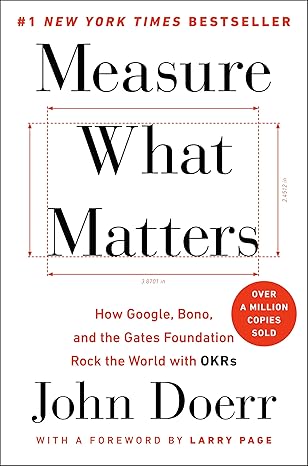
By: John Doerr
Book Title: Measure What Matters: How Google, Bono, and the Gates Foundation Rock the World with OKRs by John Doerr
Measure What Matters demonstrates that setting clear goals, aligning efforts, and tracking outcomes can revolutionize organizations of any size. By embracing OKRs, leaders can inspire teams to achieve ambitious objectives while fostering accountability, transparency, and innovation.
Measure What Matters by John Doerr introduces the concept of Objectives and Key Results (OKRs), a simple yet powerful goal-setting framework that has driven success in organizations like Google, Intel, and the Gates Foundation. OKRs help individuals and teams align their efforts, focus on measurable outcomes, and achieve ambitious goals. The book combines practical insights with real-world case studies to show how organizations can use OKRs to drive growth, innovation, and accountability.
Doerr emphasizes that OKRs foster transparency, collaboration, and agility, making them particularly valuable in dynamic environments. The book outlines best practices for setting and implementing OKRs, highlighting their potential to transform how businesses operate.
Frameworks and Strategies
1. Understanding OKRs: Objectives and Key Results
- Importance: OKRs are a system for setting goals that ensure clarity and alignment within organizations. Objectives define what you want to achieve, while Key Results specify how you’ll measure success.
- Steps to Implementation:
- Set Clear Objectives: Define ambitious, inspiring goals.
- Create Measurable Key Results: Identify quantifiable outcomes to track progress.
- Align Goals Across Teams: Ensure everyone’s OKRs contribute to organizational objectives.
- Checklist:
- Are your objectives ambitious yet achievable?
- Are your key results specific and measurable?
- Do team and individual OKRs align with organizational priorities?
2. The Benefits of Transparency in Goal Setting
- Importance: Transparency fosters accountability and collaboration by making everyone’s goals visible within the organization. It also empowers employees to align their efforts with broader objectives.
- Steps to Implementation:
- Publish OKRs organization-wide for visibility.
- Encourage feedback and discussions about alignment.
- Use OKRs in regular check-ins to monitor progress and address obstacles.
- Checklist:
- Are your OKRs accessible to all employees?
- Do team members understand how their work contributes to overall goals?
- Are OKRs reviewed and updated regularly?
3. The 4 Superpowers of OKRs
- Importance: Doerr identifies four “superpowers” that make OKRs an effective framework:
- Focus and Commit to Priorities
- Align and Connect for Teamwork
- Track for Accountability
- Stretch for Amazing
- Steps to Implementation:
- Prioritize a few key objectives to avoid overcommitment.
- Use OKRs to connect individual and team efforts to company goals.
- Monitor progress consistently and adapt as needed.
- Set “stretch goals” to push boundaries without fear of failure.
- Checklist:
- Are you focusing on a limited number of key objectives?
- Are OKRs aligned across teams and functions?
- Are you tracking progress with regular check-ins and updates?
4. Continuous Improvement with CFRs (Conversations, Feedback, Recognition)
- Importance: OKRs work best when combined with a culture of open communication and feedback. CFRs enhance employee engagement and ensure goals remain relevant and achievable.
- Steps to Implementation:
- Conduct regular one-on-one conversations to discuss progress.
- Provide constructive feedback to address challenges and refine goals.
- Recognize achievements to build morale and reinforce desired behaviors.
- Checklist:
- Are managers engaging in regular, meaningful conversations with their teams?
- Are feedback mechanisms in place to address challenges early?
- Is recognition a part of your OKR process?
5. Case Studies: Success Stories with OKRs
- Importance: Real-world examples illustrate the transformative power of OKRs. Companies like Google, Intel, and smaller startups have used OKRs to achieve extraordinary results.
- Steps to Implementation:
- Study successful case studies to understand OKR best practices.
- Apply insights to your organization’s unique needs and culture.
- Iterate and refine your OKR process over time.
- Checklist:
- Have you explored relevant OKR success stories for inspiration?
- Are you adapting best practices to fit your organization?
- Are you learning from both successes and failures in your OKR journey?
Final Checklist
- Establish clear, measurable, and inspiring OKRs.
- Foster transparency and alignment through organization-wide visibility.
- Embrace the four superpowers: focus, alignment, tracking, and stretching.
- Integrate CFRs to create a culture of feedback and recognition.
- Regularly review and refine your OKR process based on results and feedback.
https://amzn.to/3WKvKM4